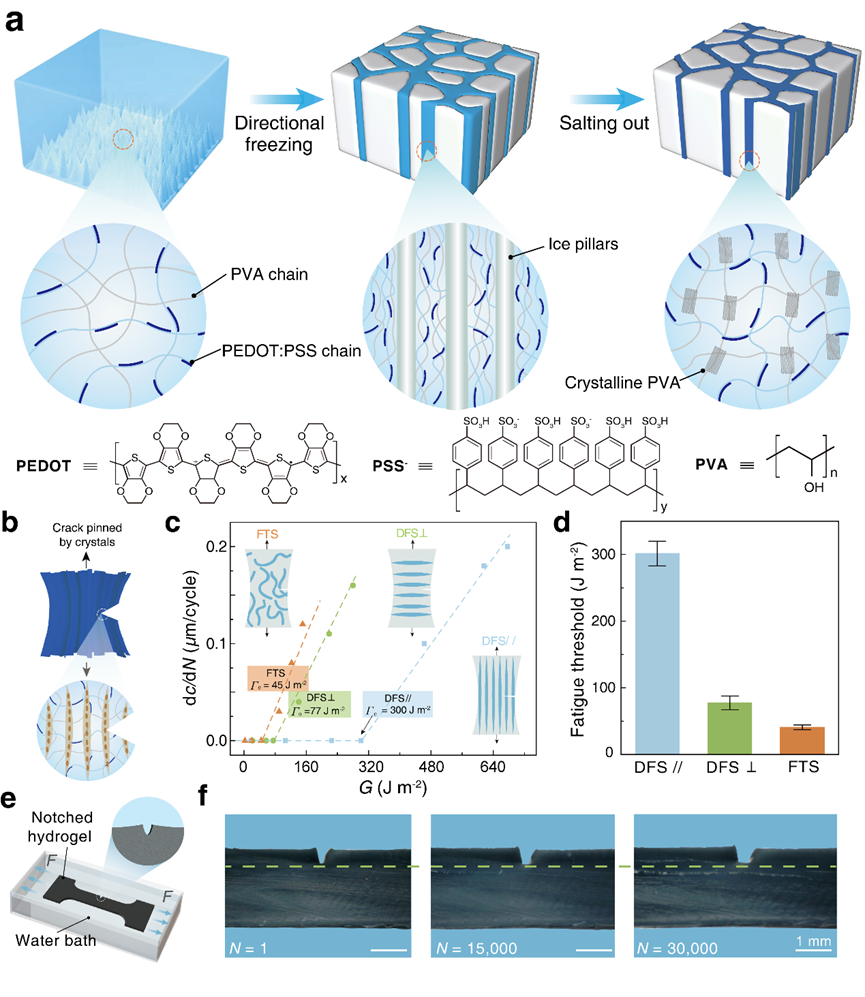In recent years,high sensitivity flexible strain sensors have attracted great attention due to their enormous prospects in fields such as soft robots,healthcare,and intelligent wearable devices.However,existing flexible strain sensors are usually limited by the operating environment,such as in rich water environments(such as sweating,underwater operation,etc.),which can weaken the sensitivity and reliability of the sensing system,and even cause device functional failures.Conductive polymer hydrogels have unique flexibility,excellent strain sensing performance and mechanical robustness,and are expected to become the core components of a new generation of strain sensors.However,the current mechanical properties of conductive polymer hydrogels,especially the fatigue resistance under long-term strain(fatigue threshold lower than 100 J m-2),are still difficult to meet the requirements of multi cycle mechanical load applications.Therefore,the development of conductive polymer hydrogels with excellent fatigue resistance is expected to solve the key challenges currently faced by underwater strain sensing systems.

Figure 1.Design principle and fatigue resistance of anti fatigue conductive polymer hydrogel.
The team selected medical polymer polyvinyl alcohol(PVA)and commercial conductive polymer PEDOT:PSS as materials for preparing conductive hydrogel,and prepared ordered anisotropic anti fatigue PEDOT:PSS-PVA conductive polymer hydrogel through directional freezing assisted salting out strategy(DFS)(Figure 1).Due to its unique ordered nanofiber structure and high crystallinity,PEDOT:PSS-PVA conductive polymer hydrogel can withstand various forms of mechanical deformation and load(more than 10000 times its own weight),and its fatigue threshold in parallel orientation can reach more than 300 J m-2(Figure 1).During 30000 consecutive cycles of stretching,the crack still did not expand and exhibited excellent fatigue resistance characteristics.
The team further integrated the conductive polymer hydrogel strain sensor into the side of the underwater robot fish as a key bearing element and motion monitoring sensor(Figure 2).During underwater swimming(video 1),the conductive polymer hydrogel undergoes periodic stretching and shrinking(energy release rate is 168 J m-2).After swimming for 16 hours,no crack growth is detected after more than 100000 cycles,which confirms the long-term reliability of the hydrogel as an underwater strain sensor.

Figure 2.Function demonstration of anti fatigue conductive polymer hydrogel as a load-bearing component and sensor of underwater robot.
Video 1.Demonstration of robot fish swimming underwater with conductive polymer hydrogel.
Zhang Zhilin,a master's student from Jiangxi Normal University of Science and Technology,Chen Guangda,a master's student from Southern University of Science and Technology,and Xue Yu,a doctoral student,are the co first authors of the paper.Professors Lu Baoyang and Liu Ji are the corresponding authors.This research has received funding from National Natural Science Foundation of China,Jiangxi Flexible Electronics Key Laboratory,Shenzhen Science and Technology Innovation Committee,and Guangdong Province Basic Research and Applied Basic Research.


 扫一扫加微信
扫一扫加微信